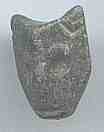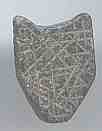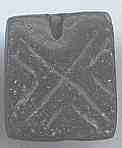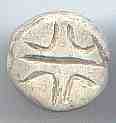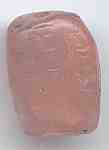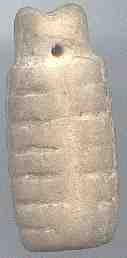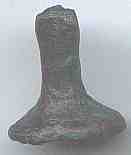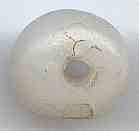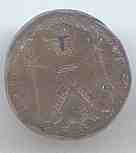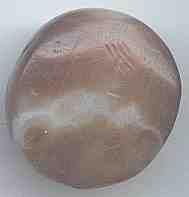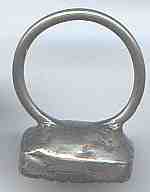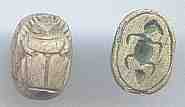 |
The Bead Site =Home>Uses of Beads>Practical Uses > Seals
Seals as Beads
Most seals are beads with at least one flat, engraved side. When pressed into sealing wax (lac1) or clay or inked and put on paper a mirror image is produced, usually idiosyncratic enough to identify the owner. Seals served as notary marks, signatures, letterheads, talismans and padlocks.
The mere ownership of the right seal conferred kingship in China, Southeast Asia and ancient Israel. The Hebrew nation was nearly wiped out because of this fact (Esther 8:8).
Seals have gone out of fashion. Few of us have seen one, much less used one. This is a very new development. Europe and America were still using them in the early 19th century. Their use elsewhere continued even later, and they are still used in some cultures, such as China and Japan.
The Center for Bead Research has a small but significant seal collection, mostly from the Middle East. I have published a catalogue of the collection, along with historical notes. I emphasized the value that an understanding of seals can bring to an understanding of bead history and vice-versa.
We also have a large library on seals, as they have been intensely studied for a long time. Bead research is breathing new life into the knowledge about seals.
What follows is a small gallery of some seals in the Center's collection. They were chosen to convey an idea of their variety and to illustrate how interesting this unusual group of beads can be.
Dimensions: The first (Halaf) seal is 1/2 inch (ca. 1.3 cm) wide. All seals are at same scale except for the small duck (150%) and the large Gayomard amulet (66%).
|
|
Some of the earliest seals are from the Halaf culture (in what is now Iraq) from ca. 5500 B.C. This unusual specimen has a dog/wolf face with the eyes marking the hole.
|
|
Distinctive of a Halaf seal is the seemingly irregular scratch pattern of the sealing surface. Each is unique, probably identifying an individual.
|
|
By about 4400 BC the Sumarians to the south broke the power of the Halaf. Their early seals resembled Halaf, ones; later they borrowed motifs from less civilized people to the West.
|
|
These are both "button seals," flat and perforated through the edges. The strong geometrical designs may have indicated commodities rather than individuals
|
|
|
|
The triumph of Mesopotamian seals is the cylinder seal, developed about the same time as writing in the region, ca 3400 BC. These were often worn on little looped frames and were standard for 2000 years.
|
|
Cylinder seals produced continuous patterns. They could be used to seal a jar or even a room. It was widely considered a very evil omen to break a sealed surface without the seal owner's permission.
|
|
An elaborate carnelian cylinder seal carved in cuneiform script with a long prayer. This is typical of the Kassite period, beginning ca. 1750 BC. It may have been more of an amulet than a seal, accounting for its low engraving (some has worn off) and irregular cross-section.
|
|
Looped cylinder seal, a variation on seals usually perforated through their long axis. A loop on top provides the hole. These were used in peripheral regions, such as Syria. This one appears to have lost its original loop and to have been perforated again in later times.
|
|
|
|
Looped cylinder/ stamp seal. These are known in Central Asia ca. 1700 BC and Urartu (Armenia) ca. 800 BC. The cylinder has an intertwined snake design. There is also a stamp seal at the bottom.
|
|
Cast bronze seal. The type was popular in Anatolia (Turkey) ca. 2500 BC, but this seal was bought in Afghanistan and is likely to be a later Central Asian type.
|
|
A dramatic change happened in the Sasanian (AD 224 to 642) period in Iran. Stamp seals returned to fashion, now with high profiles and made of quartz gems.
|
|
There is a wide variety of designs on Sasanian seals. Many are naturalistic and astronomical. This scorpion fulfills both requirements.
|
|
|
|
One of the most popular motifs was Gayomard, the first humanoid, who gave rise to Adam and Eve. Astrologically, he is Orion. His faithful dog, Yellow Ears (Sirius) runs along in front of him.
|
|
Large Gayomard seals (this reduced by a third) with shallow, sketchy designs could not be used as seals and were apparently amulets for the dead. Gayomard escorts the dead to the underworld.
|
|
The hairy face of Gayomard. The seal is made of speculum (bronze with a high tin content).
|
|
Enlarged 50%, this tiny onyx seal is cut with a standing duck.
|
|
|
|
Seal caught in time. A late Sasanian jasper seal was ground to remove the design. Then Allah was carved on its face. As it is written right to left, it was not a seal, but a talisman.
|
|
Engraved seal stones without holes were mounted in rings, the preferred method for Greek, Romans, Indians and others. This belonged to Mansoor Al-Musawi and was made in AH 1318 = AD 1899.
|
|
Most Islamic seals were mounted on frames. Two seals were joined with a chain. Abdul Hassan Ali, AH 1314 = AD 1896. (AH = Anno Hejira, the starting point for the Muslim calendar.)
|
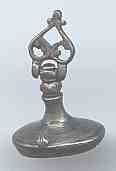
|
Teardrop or "paisley" (cypress) shaped seal of lapis lazuli. The elaborate inscription is difficult to read. Perhaps "Mohammed, friend of Abdul," AH 1284 = AD 1867.
|
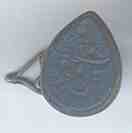
|
|
|
An unusual seal of two stones joined by a perforated gold frame. The name Marko Aj Ben Yahya in Farsi is cut on bloodstone.
|
|
The other side is a sardonyx engraved probably with the same name in Armenian script. No doubt a businessman from the Julfa district of Isfahan, Iran.
|
|
Neighbors
|
Egypt adopted the Mesopotamian cylinder seal, but by 2850 BC had substituted the scarab. These were seals, amulets and often given as presents. They were mostly carved from steatite (soapstone) and are a distinctive mark of this civilization.
|
|
|
|
The Harappan (Indus Valley) civilization of India and Pakistan (ca. 2600 to 1700 BC) developed their own seals. Carved from steatite and covered with a slip, they were flat and square with a loop on the back.
This is an aluminum impression of one of the most famous seals, representing in many scholars' view the prototype of the god Siva. The Pakistan archaeology service sells a set of ten plaster seal casts, but as far as I know, this is the only aluminum cast of this seal made.
|
|
China
|
Early Chinese seals had loops and were most often inked. In the 19th century the long chop came into fashion. This one was carved for me in Xian in 1986.
|
|
|
1 Lac (the basis of shellac and the material old cylinder and disc records were made from is produced by the female of an insect as a nest for her eggs. Her body yields a bright red dye.
Sealing wax is lac, often colored bright red. Most lac comes from India. In Middle America a similar material and coloring agent come from cochineal insects.
__________________________________________________
Small Bead Businesses | Beading & Beadwork | Ancient Beads | Trade Beads
Beadmaking & Materials | Bead Uses | Researching Beads | Beads and People
Center for Bead Research | Book Store | Free Store | Bead Bazaar
Shopping Mall | The Bead Auction | Galleries | People | Events
The Bead Site Home | Chat Line | Contact Us | Site Search Engine | FAQ
|
